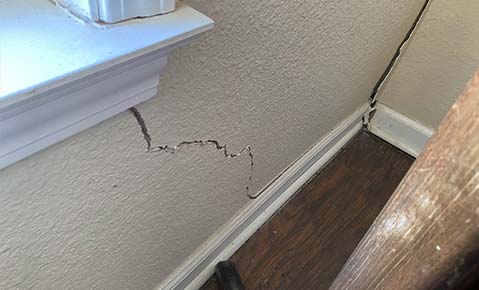Seeing your retaining wall or seawall bow, buckle, lean, or crack is concerning, to say the least. They’re meant to retain soil from lateral movement and prevent your property from becoming damaged. Unfortunately, they still sometimes fail at that task. And there is one contributing factor that causes failure: moisture.
We often forget water also has a weight that can be added to soil to exacerbate that failure. It adds pressure to walls that attempt to hold up their task of stabilizing soil. This is referred to as hydrostatic pressure.
Dalinghaus Construction does more than foundation repair, since we also service seawalls and retaining walls. They can negatively affect your foundation via cosmetic damage. They can become structural if you’re negligent of your retaining wall, which is why you want them repaired. We’ve helped over 2,300 residential and commercial property owners in Southern California, Arizona, and Nevada since 2015, helping with foundations, retaining walls, and seawalls. With over 100 years of combined experience, we understand how hydrostatic pressure affects your retaining wall or seawall.
What is hydrostatic pressure?
The first thing that comes to mind when answering this is “water weight.”
It’s when the weight of moisture adds pressure to a structure. Water already weighs roughly 8.34 pounds per gallon. Imagine that weight being added to lateral moving soil that’s already being assisted by gravity.
When you’re living on a hill or slope, your property is already dealing with the soil’s lateral movement with the help of gravity. Hydrostatic pressure can exacerbate damage to your retaining wall or seawall.
Moisture buildup is the top reason your retaining wall is failing.
You’ll find that your retaining wall suffers from damage due to improper drainage, which causes moisture to build up from behind, add pressure, and cause failure. Proper drainage helps relieve hydrostatic pressure in your retaining wall or seawall since moisture will escape from the soil.
You have to relieve the hydrostatic pressure by adding drainage and weep holes so the water can leave and isn’t building against the structure. You also need the water to be channeled from the weep holes.
If water keeps seeping through the weep holes without proper drainage, soil goes with it. Over time, the soil will eventually erode and need to be replaced by adding additional soil or adding polyurethane for soil densification.
How does hydrostatic pressure affect my retaining wall or seawall?
Both types of walls have the same purpose of protecting your property and retaining the soil behind them. Seawalls have the added factor of blocking large masses of water from stealing your land, causing soil erosion.
All the “water weight” applied to your retaining wall or seawall can cause them to bow, buckle, lean, or even crack if enough pressure is applied. “Water weight” is the top contributor to retaining wall or seawall failure. You don’t want this, especially when it means you’ll have to replace them. Replacing a seawall or retaining wall is generally more expensive than repairing it.
If you don’t believe us, look at the costs of retaining walls new and repaired.
While moisture is the top cause of retaining wall failure, soils can be dry and cause a wall to fail solely from lateral movement.
Solutions to combatting hydrostatic pressure for your retaining wall and seawall
You’ll want to make sure you’re able to repair your retaining wall or seawall now, especially when the result of failure can mean you’ll have to replace them. Replacing these walls is more expensive than the repair.
Proper drainage
V-drains can be installed at the footing of your retaining wall so the moisture can be properly drained from your retaining wall. You want moisture to be lead away from your property so it doesn’t cause unnecessary damage in the future, whether it’s due to hydrostatic pressure or concrete spalling.
Polyurethane injection
For seawalls, we use a single-component polyurethane to strengthen the soil it retains and relieve the buildup of hydrostatic pressure. A two-component polyurethane runs the risk of blowing out a seawall or retaining wall since it doesn’t use moisture to expand, while the single component reacts when first exposed to moisture.
Weep holes
For seawalls and retaining walls, and depending on what type of wall you have, Dalinghaus Construction can install JET Filters, which are a type of weep hole that allows water to escape without taking soil with it.
Carbon Fiber wrapping
Finally, you can have Carbon Fiber wrapping applied to cracks as part of your seawall or retaining wall repair. This is an excellent solution for seawalls since Carbon Fiber wrapping provides additional strength and prevents water from seeping through the gaps toward your rebar.
You’ll also have Carbon Fiber wraps put on your retaining wall, especially at corners to hold the wall together as it combats hydrostatic pressure.
Don’t wait – schedule your retaining wall or seawall inspection
You’ve learned about hydrostatic pressure, how it affects your retaining wall or seawall, and solutions for combatting moisture buildup. If you’re concerned about your walls failing, you want to schedule an inspection.
You can’t control the water abundance when the rains come and how hydrostatic pressure damages the structures that are meant to protect your property. Alleviating hydrostatic pressure applied to your wall is something you can control.
You want to take the integrity of your retaining wall or seawall seriously, especially when they aid in ensuring the longevity, stability, and value of your property.
You’re better off repairing your seawall or retaining walls now so you don’t have to pay more for extensive damages later.
Check out our video with Mark Cook about retaining wall inspections and repairs.
Also take the time to learn more on similar subjects such as how to repair a seawall once and for all, the six causes for seawall failure, and how retaining walls are repaired.
For additional questions or to schedule an evaluation, call Dalinghaus Construction at (877)360-9277.





